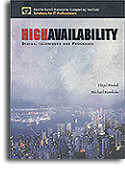High Availability
 |
Design, Techniques and ProcessesFirst edition; 286 pages ISBN: 0-13-096288-0 ( by: Floyd Piedad and Michael Hawkins ) |
| High Availability | BUY THIS BOOK
|
The complete “how-to guide” for maximizing the availability of enterprise systems
Training, support, backup, and maintenance account for nearly 80 percent of the total cost of today’s enterprise applications – and much of that money is spent trying to squeeze increased availability out of applications in spite of weak design and management processes. In High Availability, two leading IT experts bring together best practices for every people and process-related issue associated with maximizing application availability. The goal: to help enterprises dramatically improve the value of their strategic applications, without investing a dime more than necessary.
- Enhancing all four key elements of availability: reliability, recoverability, serviceability, and manageability
- Understanding how your users define availability
- Planning achievable service level agreements – and delivering on them
- Strategies for multiple platforms, from the mainframe to the desktop
- Lowering administrative costs through standardization and other techniques
- Redundancy, backup, fault tolerance, partitioning, automation, and other high availability solutions
- Leveraging availability features built into your existing hardware and operating systems
Discover how to create systems that will be easier to maintain, anticipate and prevent problems, and define ongoing availability strategies that account for business change. Whatever your IT role, whatever your IT architecture, this book can help you deliver the breakthrough availability levels your organization needs right now.
About the Authors
Floyd Piedad is President of AKAsia Services Corporation, a leading Internet services company based in Manila, the Philippines.
Michael W. Hawkins is an IT management consultant who specializes in implementing and managing large IT infrastructures for companies throughout Asia and North America. He is based in Manila, The Philippines.

















